DOWNLOAD ROUNDUP, NOVEMBER 2008
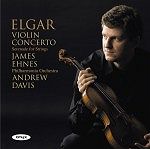 My
Download of the Month is James
Ehnes’ performance of the Elgar
Violin Concerto (Onyx ONYX4025).
I downloaded this from theclassicalshop.net.;
it’s also available from eMusic. The
live recording (rehearsal and public
performances at the Queen Elizabeth
Hall, May 2007) sounds more than adequate
in 320k mp3 sound. For me, this new
version just ousts Nigel Kennedy’s first
recording as my version of choice among
modern recordings – in fact, it reminded
me of the classic 1934 Menuhin-Elgar
version. The coupling, Serenade for
Strings, is an added attraction.
No booklet with either version, but
the music is pretty well known. [The
CD is available
from Musicweb for £12 Sale
or Return review
]
My
Download of the Month is James
Ehnes’ performance of the Elgar
Violin Concerto (Onyx ONYX4025).
I downloaded this from theclassicalshop.net.;
it’s also available from eMusic. The
live recording (rehearsal and public
performances at the Queen Elizabeth
Hall, May 2007) sounds more than adequate
in 320k mp3 sound. For me, this new
version just ousts Nigel Kennedy’s first
recording as my version of choice among
modern recordings – in fact, it reminded
me of the classic 1934 Menuhin-Elgar
version. The coupling, Serenade for
Strings, is an added attraction.
No booklet with either version, but
the music is pretty well known. [The
CD is available
from Musicweb for £12 Sale
or Return review
]
 One
advantage of downloading is that it
encourages exploration of the back catalogue.
The Metronome recording of the music
of John Dunstaple, or Dunstable,
one of the English composers of the
15th century to have had
a considerable international reputation,
is a case in point. The Orlando Consort
couple the four movements of the Missa
Rex seclorum with eleven shorter
pieces, all prime reasons for that reputation,
in first-rate performances. Some of
the tracks just fall below the magic
bit-rate of 192k but the sound is more
than acceptable. If you insist on having
a higher bit-rate, iTunes offer this
recording in their ‘plus’ format but
at a higher price than eMusic (15 tracks
out of a monthly allowance of 50 tracks
works out at about £3.60). (METCD1009).
One
advantage of downloading is that it
encourages exploration of the back catalogue.
The Metronome recording of the music
of John Dunstaple, or Dunstable,
one of the English composers of the
15th century to have had
a considerable international reputation,
is a case in point. The Orlando Consort
couple the four movements of the Missa
Rex seclorum with eleven shorter
pieces, all prime reasons for that reputation,
in first-rate performances. Some of
the tracks just fall below the magic
bit-rate of 192k but the sound is more
than acceptable. If you insist on having
a higher bit-rate, iTunes offer this
recording in their ‘plus’ format but
at a higher price than eMusic (15 tracks
out of a monthly allowance of 50 tracks
works out at about £3.60). (METCD1009).

 My
recent recommendation of a splendid
Hyperion CD of the music of Nicholas
Gombert (c.1495-c.1560) with
Stephen Rice directing the Brabant Ensemble
(Tribulatio et angustia, CDA67614
CD
review) reminds me that the Brabant
Ensemble didn’t begin Gombert’s modern
rehabilitation, which was already under
way with two CDs recorded by The
Tallis Scholars and Peter Phillips
in 2001. These Gimell CDs contain all
eight of Gombert’s late-period settings
of the Magnificat, four per CD,
each with an appropriate plainsong antiphon
sung before and after. (CDGIM037 CD
review and CDGIM038
CD review). Readers may well find
these Gimell recordings more to their
liking – the music is more approachable,
though it contains what Peter Phillips
in his excellent notes describes as
striking discords, and everything is
excellently sung and recorded. These
recordings can be downloaded from the
Gimell website (gimell.com) in decent
mp3 sound for £7.99 or as CD-quality
wma or flac downloads for £9.99. I tried
one in wma and one in flac format and
am delighted to report that, as usual
with Gimell, their lossless recordings
truly are of CD quality. You might wish
to burn them onto audio-quality CDRs
rather than the usual kind, to preserve
the quality. As with all Gimell downloads,
purchase includes the right to download
the booklet of notes and the tray insert.
My
recent recommendation of a splendid
Hyperion CD of the music of Nicholas
Gombert (c.1495-c.1560) with
Stephen Rice directing the Brabant Ensemble
(Tribulatio et angustia, CDA67614
CD
review) reminds me that the Brabant
Ensemble didn’t begin Gombert’s modern
rehabilitation, which was already under
way with two CDs recorded by The
Tallis Scholars and Peter Phillips
in 2001. These Gimell CDs contain all
eight of Gombert’s late-period settings
of the Magnificat, four per CD,
each with an appropriate plainsong antiphon
sung before and after. (CDGIM037 CD
review and CDGIM038
CD review). Readers may well find
these Gimell recordings more to their
liking – the music is more approachable,
though it contains what Peter Phillips
in his excellent notes describes as
striking discords, and everything is
excellently sung and recorded. These
recordings can be downloaded from the
Gimell website (gimell.com) in decent
mp3 sound for £7.99 or as CD-quality
wma or flac downloads for £9.99. I tried
one in wma and one in flac format and
am delighted to report that, as usual
with Gimell, their lossless recordings
truly are of CD quality. You might wish
to burn them onto audio-quality CDRs
rather than the usual kind, to preserve
the quality. As with all Gimell downloads,
purchase includes the right to download
the booklet of notes and the tray insert.
 Last
year I
recommended an excellent bargain
2-CD distillation of the performances
of complete works of Tallis by
Chapelle du Roi (Portrait PCL2101).
That set remains available and represents
excellent value – I’ve seen it on offer
for as little as £4.75 – but aficionados
will want some or all of the complete
series, still available from Signum.
All the volumes are available as downloads
from theclassicalshop.net, eMusic and
classicsonline.com. I’ve sampled all
these and they all reproduce well, at
least at 192k, though only the classicsonline
versions come at a guaranteed 320k.
They’re also available from iTunes in
the ‘plus’ format but, as I don’t have
reviewing access to iTunes, I can’t
comment on their versions, except to
say that if you require the supplementary
‘bonus’ CD which accompanies Volume
9, only iTunes seem to offer this –
and that at twice the normal price:
so much for the depreciation of the
word ‘bonus’. You’d be well advised,
therefore, to buy Volume 9 on CD.
Last
year I
recommended an excellent bargain
2-CD distillation of the performances
of complete works of Tallis by
Chapelle du Roi (Portrait PCL2101).
That set remains available and represents
excellent value – I’ve seen it on offer
for as little as £4.75 – but aficionados
will want some or all of the complete
series, still available from Signum.
All the volumes are available as downloads
from theclassicalshop.net, eMusic and
classicsonline.com. I’ve sampled all
these and they all reproduce well, at
least at 192k, though only the classicsonline
versions come at a guaranteed 320k.
They’re also available from iTunes in
the ‘plus’ format but, as I don’t have
reviewing access to iTunes, I can’t
comment on their versions, except to
say that if you require the supplementary
‘bonus’ CD which accompanies Volume
9, only iTunes seem to offer this –
and that at twice the normal price:
so much for the depreciation of the
word ‘bonus’. You’d be well advised,
therefore, to buy Volume 9 on CD.
A word of warning about the Portrait
CDs – the tracks on CD2 are mis-numbered,
so what you see on your player is not
the number in the booklet. MusicWeb
alerted the manufacturers to the problem,
but I haven’t yet heard that it’s been
corrected. So far I’ve listened to Volumes
1 to 6 of the complete series and have
no criticisms worth mentioning of any
of the singing – much as I like the
Tallis Scholars and The Sixteen in this
repertoire, Alistair Dixon’s group offers
them a strong challenge.
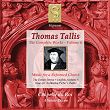 SIGCD001
contains the early music, written in
the reign of Henry VIII, SIGCD002 his
music on the cusp of the Reformation
and SIGCD003 the music for the restoration
of the Latin liturgy under Queen Mary,
including an especially fine account
of the Mass Puer natus est nobis
– but don’t forget the equally fine
version of this Mass on Music for
Philip and Mary (COR16037) on a
recording by The Sixteen which I recommended
in last month’s Roundup.
SIGCD001
contains the early music, written in
the reign of Henry VIII, SIGCD002 his
music on the cusp of the Reformation
and SIGCD003 the music for the restoration
of the Latin liturgy under Queen Mary,
including an especially fine account
of the Mass Puer natus est nobis
– but don’t forget the equally fine
version of this Mass on Music for
Philip and Mary (COR16037) on a
recording by The Sixteen which I recommended
in last month’s Roundup.
Volumes 4 and 5 (SIGCD010 and 016)
offer the Latin music for the Divine
Office, while Volume 6 (SIGCD022), Music
for a Reformed Church, includes
Tallis’s settings of the sung portions
of Anglican Mattins, Evensong and Holy
Communion. Much of this sixth volume
is mainly of academic interest but the
anthems and the music from Archbishop
Parker’s Psalter are of interest, especially
as Vaughan Williams’ famous Fantasia
on a Theme of Thomas Tallis is
based on one of those psalm tunes.
I hope to deal with the remaining volumes
in next month’s Roundup – a problem
with my mobile broadband, caused by
a mast down which has taken an interminable
time to put right, has delayed me considerably.
None of these sites offer any notes
– nothing more than a high-res image
of the cover, including the misprint
on the cover of Volume 5 – but Signum
very generously provide notes and texts
for each volume on their website; you’ll
have to cut and paste them and make
your own booklet. Be aware that the
track-listing for Volume 6 on the website
reverses the order in which tracks 10
and 11 download and in which the texts
are listed.

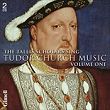 I
mustn’t, however, forget to draw your
attention to two recent 2-CD-for-1 compilations
of Tudor Music by the Tallis
Scholars on the Gimell label (CDGIM209
and 210). I’ve already
recommended these in CD form and
they’re also available as mp3s and lossless
downloads from the Gimell website –
sublime singing and superb value in
whatever form you choose to buy them.
CDGIM209 contains the music of John
Browne, William Cornysh, Tohn Taverner
and Christopher Tye, the latter two
being represented by their Western
Wynde Masses. CDGIM210 contains
music by John Sheppard, Thomas Tallis
and Robert White. All the performances
are strong contenders for best versions
of their respective works and I have
always found the Gimell lossless downloads
to be the equal of the CDs. You also
get all the notes and artwork from the
CDs when you download. I made the CDs
Bargain of the Month and I see
no reason to withhold the title from
the download versions.
I
mustn’t, however, forget to draw your
attention to two recent 2-CD-for-1 compilations
of Tudor Music by the Tallis
Scholars on the Gimell label (CDGIM209
and 210). I’ve already
recommended these in CD form and
they’re also available as mp3s and lossless
downloads from the Gimell website –
sublime singing and superb value in
whatever form you choose to buy them.
CDGIM209 contains the music of John
Browne, William Cornysh, Tohn Taverner
and Christopher Tye, the latter two
being represented by their Western
Wynde Masses. CDGIM210 contains
music by John Sheppard, Thomas Tallis
and Robert White. All the performances
are strong contenders for best versions
of their respective works and I have
always found the Gimell lossless downloads
to be the equal of the CDs. You also
get all the notes and artwork from the
CDs when you download. I made the CDs
Bargain of the Month and I see
no reason to withhold the title from
the download versions.
 The
flood of CDs brought to us by various
companies in celebration of Buxtehude
2007 tercentenary is finally slowing,
though I have only recently reviewed
and recommended the third and final
volume of the Naxos reissue of Lars
Ulrik Mortensen’s complete harpsichord
works (8.570581). I missed out on the
Op.1 and Op.2 Sonatas in that
Naxos series but two recordings from
Arts Blue Line by the young Italian
group L’Estravagante have filled
the gap very ably (77318 and 77328)
in performances which fully live up
to the group’s name in the best meaning
of that term. Apart from those who must
have these recordings in SACD format,
most will be more than happy with the
quality of the 320k download available
from theclassicalshop.net.
The
flood of CDs brought to us by various
companies in celebration of Buxtehude
2007 tercentenary is finally slowing,
though I have only recently reviewed
and recommended the third and final
volume of the Naxos reissue of Lars
Ulrik Mortensen’s complete harpsichord
works (8.570581). I missed out on the
Op.1 and Op.2 Sonatas in that
Naxos series but two recordings from
Arts Blue Line by the young Italian
group L’Estravagante have filled
the gap very ably (77318 and 77328)
in performances which fully live up
to the group’s name in the best meaning
of that term. Apart from those who must
have these recordings in SACD format,
most will be more than happy with the
quality of the 320k download available
from theclassicalshop.net.
I’m planning to write in greater detail
next month about the new recording by
The Sixteen of Handel’s Messiah
(Coro COR16062, 2 CDs) – though it was
designed to be Easter music, it’s come
to be associated more with Christmas.
In the interim, let me just say that
you needn’t hesitate to go for this
new version; with very slight reservations,
it’s one of the best on the market,
and the 320k mp3 download from theclassicalshop.net
is excellent. The only snag is that
if you download, you’ll have to pay
if you want the ‘bonus’ disc of excerpts
from earlier recordings by The Sixteen,
which comes free with the CDs. Somebody
at Chandos has scrambled this to read
‘buns disc’, which is somehow appropriate;
if it isn’t free, it isn’t a bonus.
 I’m
not sure how many versions of Schubert’s
Symphony No.9 in C Sir Charles
Mackerras has made but he has now
re-recorded it with the Philharmonia
Orchestra (Signum SIGCD133). I downloaded
this from theclassicalshop.net.; it’s
also available from eMusic. The tempi
are very close to his earlier version
with the Orchestra of the Age of Enlightenment
(Virgin Classics) – the slightly faster
outer movements and the slightly slower
second movement in the new recording
are both to the advantage of the music.
Though this version was made with a
modern-instrument orchestra, much of
the period flavour of the OAE recording
is maintained. I grew up musically with
Bruno Walter’s and Thomas Beecham’s
Schubert – the latter still has the
power to captivate but Mackerras now
makes Walter seem rather stodgy. The
live recording (QEH, June 2006) is offered
in very decent 320k mp3 sound.
I’m
not sure how many versions of Schubert’s
Symphony No.9 in C Sir Charles
Mackerras has made but he has now
re-recorded it with the Philharmonia
Orchestra (Signum SIGCD133). I downloaded
this from theclassicalshop.net.; it’s
also available from eMusic. The tempi
are very close to his earlier version
with the Orchestra of the Age of Enlightenment
(Virgin Classics) – the slightly faster
outer movements and the slightly slower
second movement in the new recording
are both to the advantage of the music.
Though this version was made with a
modern-instrument orchestra, much of
the period flavour of the OAE recording
is maintained. I grew up musically with
Bruno Walter’s and Thomas Beecham’s
Schubert – the latter still has the
power to captivate but Mackerras now
makes Walter seem rather stodgy. The
live recording (QEH, June 2006) is offered
in very decent 320k mp3 sound.
 Fauré’s
Violin Sonata No.1, ‘Dolly’ Suite
and Piano Quintet No.2, are very
well performed by the Nash Ensemble
with Susan Tomes on CRD3505 in very
decent 192k mp3 sound for a mere £4.80
from theclassicalshop.net. There are
no notes and even the ‘full size’ cover
picture is too low-res to use but who
cares at the price – be creative and
make your own cover: there are plenty
of images of Impressionist paintings
on the web that will serve the purpose.
Don’t try to cut and paste the details
from the web page straight into Word
– you’ll end up with a lot of formatting
that you don’t want; cut and paste into
a basic programme like Notepad first,
then from there into Word to lose the
unwanted formatting.
Fauré’s
Violin Sonata No.1, ‘Dolly’ Suite
and Piano Quintet No.2, are very
well performed by the Nash Ensemble
with Susan Tomes on CRD3505 in very
decent 192k mp3 sound for a mere £4.80
from theclassicalshop.net. There are
no notes and even the ‘full size’ cover
picture is too low-res to use but who
cares at the price – be creative and
make your own cover: there are plenty
of images of Impressionist paintings
on the web that will serve the purpose.
Don’t try to cut and paste the details
from the web page straight into Word
– you’ll end up with a lot of formatting
that you don’t want; cut and paste into
a basic programme like Notepad first,
then from there into Word to lose the
unwanted formatting.
From the same source comes an equally
desirable recording of Fauré’s
La Bonne Chanson (Sarah Walker)
and the Trio in d minor, Op120
(CRD3389). The low price largely compensates
for the very short playing time. CRD3305
offers the much better playing time
of 72:30.
I’m afraid that the Naxos recording
of Richard Strauss’s Alpine Symphony
(8.557811: Staatskapelle Weimar/Antoni
Wit) is a complete no-no for downloading.
With the music continuous across 22
tracks, there are just too many short
glitches for comfortable listening.
I listened to the download from Naxos’s
home site, classicsonline.com and cannot
imagine that other suppliers are able
to improve matters. The performance
and the sound quality (mp3 at 320k)
are excellent, but the minute hiatuses
were simply too troublesome, even using
a programme which doesn’t create artificial
gaps. Don’t even dream of burning it
to CD or syncing to an mp3 player using
Windows Media Player, which adds 2-second
gaps between tracks.
 If
you want the Naxos version of the Alpine
Symphony – and you could do a great
deal worse – you ought to buy it on
CD; after all, that isn’t a great deal
more expensive than the download. If
you are looking for a download source
without the glitches, go for the Royal
Scottish National Orchestra under
Neeme Järvi from theclassicalshop.net
(CHAN7009). This offers another excellent
performance and comes with a substantial
filler in the form of Tod und
Verklärung. I still counted
one minor transition blip on the wma
version, but it was far less troublesome
than the Naxos, and the wma sound is,
if anything, better than Naxos’s 320k
mp3 (as, indeed, it should be). There
is also an mp3 version of this Chandos
recording at a lower price – and mp3s
from theclassicalshop come with the
ability of joining tracks to avoid dropouts:
you should at least join tracks 4 and
5. This is a 2-CD set, but it is possible
to download just CD1 if you wish.
If
you want the Naxos version of the Alpine
Symphony – and you could do a great
deal worse – you ought to buy it on
CD; after all, that isn’t a great deal
more expensive than the download. If
you are looking for a download source
without the glitches, go for the Royal
Scottish National Orchestra under
Neeme Järvi from theclassicalshop.net
(CHAN7009). This offers another excellent
performance and comes with a substantial
filler in the form of Tod und
Verklärung. I still counted
one minor transition blip on the wma
version, but it was far less troublesome
than the Naxos, and the wma sound is,
if anything, better than Naxos’s 320k
mp3 (as, indeed, it should be). There
is also an mp3 version of this Chandos
recording at a lower price – and mp3s
from theclassicalshop come with the
ability of joining tracks to avoid dropouts:
you should at least join tracks 4 and
5. This is a 2-CD set, but it is possible
to download just CD1 if you wish.
 I
fell in love with J B Foerster’s
Velika noc (Easter Eve) Symphony
from a Supraphon LP, picked up in a
sale, with the Prague Symphony Orchestra
conducted by Vačlav
SmetŠček. That same
recording is once more available from
Supraphon (111 822-2) and as a first-rate
mp3 recording from eMusic. It’s only
at 192k or a little higher for some
tracks, but the ADD sound, like the
DDD recording of the symphonic poem
Springtime and Desire which has
been added, reproduces very well. Even
with the filler, the CD plays for little
more than an hour, but one of the advantages
of downloading is the ability to create
your own programme. Adding Me mladi
(My Youth), the coupling from the equally
fine Naxos CD of the symphony (8.557776,
also available from eMusic) extends
the programme by a further 16 minutes;
the performance by the Slovak Radio
Symphony Orchestra under Lance
Friedel is every bit the equal of
the Supraphon performers and the DDD
recording, if anything, even better.
This really is the music of a neglected
composer and, even with the ‘borrowed’
track, will cost you very little.
I
fell in love with J B Foerster’s
Velika noc (Easter Eve) Symphony
from a Supraphon LP, picked up in a
sale, with the Prague Symphony Orchestra
conducted by Vačlav
SmetŠček. That same
recording is once more available from
Supraphon (111 822-2) and as a first-rate
mp3 recording from eMusic. It’s only
at 192k or a little higher for some
tracks, but the ADD sound, like the
DDD recording of the symphonic poem
Springtime and Desire which has
been added, reproduces very well. Even
with the filler, the CD plays for little
more than an hour, but one of the advantages
of downloading is the ability to create
your own programme. Adding Me mladi
(My Youth), the coupling from the equally
fine Naxos CD of the symphony (8.557776,
also available from eMusic) extends
the programme by a further 16 minutes;
the performance by the Slovak Radio
Symphony Orchestra under Lance
Friedel is every bit the equal of
the Supraphon performers and the DDD
recording, if anything, even better.
This really is the music of a neglected
composer and, even with the ‘borrowed’
track, will cost you very little.
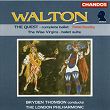 There
was a time when no primary school assembly
was complete without the playing of
a 7" ep of Sheep may safely
graze from Walton’s Bach-based
ballet The Wise Virgins.
That music is rather out of fashion
nowadays but I have to admit to a weak
spot for this kind of updated baroque.
For all my love of authentic performance,
it finds a ready response in me. So,
too, do Respighi’s baroque-based works,
such as the Ancient Airs and Dances
and Gli Uccelli (The Birds).
Both the Walton Wise Virgins
and Respighi’s Birds are available
as downloads from Chandos’s theclassicalshop.net.
The Walton comes on CHAN8871 with the
complete ballet The Quest
– a less immediately appealing work,
but well worth getting to know. The
performances (LPO/Bryden Thomson)
are excellent and the lossless recording
first-rate; there’s also a less expensive
mp3, albeit at an adequate 192k rather
than the more recommendable 320k.
There
was a time when no primary school assembly
was complete without the playing of
a 7" ep of Sheep may safely
graze from Walton’s Bach-based
ballet The Wise Virgins.
That music is rather out of fashion
nowadays but I have to admit to a weak
spot for this kind of updated baroque.
For all my love of authentic performance,
it finds a ready response in me. So,
too, do Respighi’s baroque-based works,
such as the Ancient Airs and Dances
and Gli Uccelli (The Birds).
Both the Walton Wise Virgins
and Respighi’s Birds are available
as downloads from Chandos’s theclassicalshop.net.
The Walton comes on CHAN8871 with the
complete ballet The Quest
– a less immediately appealing work,
but well worth getting to know. The
performances (LPO/Bryden Thomson)
are excellent and the lossless recording
first-rate; there’s also a less expensive
mp3, albeit at an adequate 192k rather
than the more recommendable 320k.
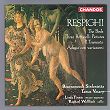 Respighi’s
Birds come with the Three Botticelli
Pictures and Il Tramonto as
first-rate couplings in first-rate performances
from the Bournemouth Sinfonietta
and Tamás Vasary and the
lossless recording is again of CD quality.
(CHAN8913) There’s also a cheaper 192k
mp3 version. One small correction to
the rather brief notes in the booklet:
O come, o come, Emmanuel, which
Respighi weaves into The Adoration
of the Magi movement, is an Advent
hymn, not for Epiphany.
Respighi’s
Birds come with the Three Botticelli
Pictures and Il Tramonto as
first-rate couplings in first-rate performances
from the Bournemouth Sinfonietta
and Tamás Vasary and the
lossless recording is again of CD quality.
(CHAN8913) There’s also a cheaper 192k
mp3 version. One small correction to
the rather brief notes in the booklet:
O come, o come, Emmanuel, which
Respighi weaves into The Adoration
of the Magi movement, is an Advent
hymn, not for Epiphany.

 Returning
to Walton, we’re spoiled for
choice for his symphonies. The Naxos
recording of Symphony No.1 (8.553180
English Northern Philharmonia/Paul
Daniel) is available from eMusic,
whence I obtained it, classsicsonline
and theclassicalshop. Again, all three
offer at least 192k, with classicsonline
only at 320k. There’s also an equally
fine LSO Live version with Colin Davis
to be had from theclassicalshop, again
in more than acceptable mp3 sound though
not, of course in the SACD format in
which the disc may be obtained (LSO0076).
eMusic offer practically the whole LSO
catalogue but not, apparently, this
recording. Both performances are fully
recommendable, but the Naxos is more
generous in also offering the Partita.
Full notes are available from the Naxos
website.
Returning
to Walton, we’re spoiled for
choice for his symphonies. The Naxos
recording of Symphony No.1 (8.553180
English Northern Philharmonia/Paul
Daniel) is available from eMusic,
whence I obtained it, classsicsonline
and theclassicalshop. Again, all three
offer at least 192k, with classicsonline
only at 320k. There’s also an equally
fine LSO Live version with Colin Davis
to be had from theclassicalshop, again
in more than acceptable mp3 sound though
not, of course in the SACD format in
which the disc may be obtained (LSO0076).
eMusic offer practically the whole LSO
catalogue but not, apparently, this
recording. Both performances are fully
recommendable, but the Naxos is more
generous in also offering the Partita.
Full notes are available from the Naxos
website.
 eMusic
and theclassicalshop also offer the
Naxos version of Symphony No.2
– it’s not as immediately appealing
as its predecessor, but I’m surprised
at its comparative neglect. I’m going
to recommend, however, Chandos’s own
recording from theclassicalshop, chiefly
because the coupling is more unusual
and more adventurous – the suite which
Christopher Palmer made from Walton’s
little-heard Troilus and Cressida,
music which certainly deserves to be
heard. The performances (LPO/Bryden
Thomson) are excellent and the lossless
recording fully CD quality. There’s
also a very decent mp3 version available
more inexpensively.
eMusic
and theclassicalshop also offer the
Naxos version of Symphony No.2
– it’s not as immediately appealing
as its predecessor, but I’m surprised
at its comparative neglect. I’m going
to recommend, however, Chandos’s own
recording from theclassicalshop, chiefly
because the coupling is more unusual
and more adventurous – the suite which
Christopher Palmer made from Walton’s
little-heard Troilus and Cressida,
music which certainly deserves to be
heard. The performances (LPO/Bryden
Thomson) are excellent and the lossless
recording fully CD quality. There’s
also a very decent mp3 version available
more inexpensively.
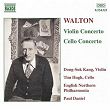 Finally,
let me recommend the Naxos coupling
of Walton’s Violin Concerto (Dong-Suk
Kang) and Cello Concerto (Tim
Hugh), available from eMusic, classicsonline
and theclassicalshop. (8.554325, ENP/Paul
Daniel again). My only reservation
about this recording is that it cuts
across my favourite coupling, of the
Violin and Viola Concertos with Nigel
Kennedy on EMI, but I imagine that most
listeners would prefer the Cello Concerto
as coupling, especially when it’s so
well performed.
Finally,
let me recommend the Naxos coupling
of Walton’s Violin Concerto (Dong-Suk
Kang) and Cello Concerto (Tim
Hugh), available from eMusic, classicsonline
and theclassicalshop. (8.554325, ENP/Paul
Daniel again). My only reservation
about this recording is that it cuts
across my favourite coupling, of the
Violin and Viola Concertos with Nigel
Kennedy on EMI, but I imagine that most
listeners would prefer the Cello Concerto
as coupling, especially when it’s so
well performed.
Brian Wilson

